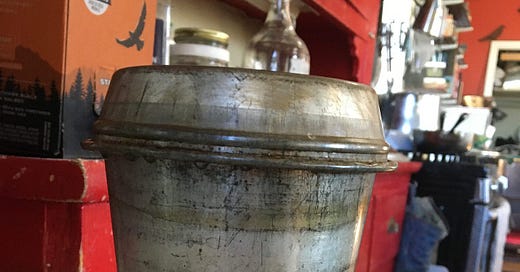Dear bread buddies,
Do you have a brown bread memory? As in Boston Brown Bread? Here’s mine:
Taking a can of Dromedary brand brown bread from the corner cupboard that spun and had three shelves. Cranking the can opener around the lid and finding the magic moist brown bread, studded with raisins or dates, crazy as a prank can of snakes, spring loaded and made of cloth. Bread in a can? Yes. And delicious.
I’d cut round slices to make myself cream cheese sandwiches for school, wrapped up in waxed paper and carried in my Snoopy lunch box till it wore out, and then, a paper bag. I couldn’t have imagined my so-called grownup life, a million moments and sandwiches ahead - but here I am, desk- and kitchen-bound, fascinated by the stories bread holds and unfolds.
Boston Brown Bread is like a museum. Its ingredients — cornmeal, rye flour & eventually wheat and molasses when they became common; its leavening methods — sourdough, baking soda; and baking styles — as a hearth bread & steamed on top of cast iron cookstoves, are an historical tour of America.
Corn is native to the Americas. Wheat and rye are travelers here, like white people. Wheat didn’t take to coastal New England as well as the Pilgrims did, so the settler-colonists adapted, making cornmeal rye a basic food in early U.S.. Food historian and cookbook author Paula Marcoux gives a good video intro to colonial brown bread. Her recipe for Steamed Brown Bread is from 1860, and makes a lovely, candy-sweet cake-bread. Her book Cooking with Fire is terrific, and has her recipe also.
The popularity of steamed brown bread tells a kitchen transition story: of moving from hearth breads or beehive and brick ovens to cast iron cookstoves. As these tools became affordable, their ovens were not reliable. The heat was irregular, so American cooks favored a steamed bread, which did wonderfully well in a kettle on top of the cookstove.

Cornmeal rye was a very common bread flour mix until grain farming was centralized into a few areas in North America, credited to advances in transportation and technology. The march of food progress is less pretty when its sweeping generalizations are broken down into actual parts: The forced removals and genocide of Indigenous peoples from their lands, the donation of said stolen land to privately owned railroad companies by the U.S. Government, and the migration of German Russian wheat-planting immigrants to the Plains.
Boston Brown Bread tastes sweet as candy, thanks to the gelatinization of starches in the cornmeal when bloomed in boiled water, and the molasses. However, the sweetness contradicts the brutal realities of our country’s roots — from Pilgrims ‘finding’ and ‘discovering’ stores of native corn, to the genocide of Indigenous peoples as geopolitical boundaries of the U.S.A. took shape. Molasses has its own ugly truth, in the Triangular Trade. What do I do with these facts?
As I was baking this morning, I thought about how good I feel when I’m handling cornmeal and rye. I love the tastes they make, sweet and earthy. I have celebrated the presence and prevalence of these grains, developing recipes for pancakes, muffins and breads to show that bread is not just wheat and sandwiches, but a staple food that morphs to suit our situations.
We eat where and what we are, which is why reconciling the realities of what corn represents is a challenge. I wonder: Would it be better just to stop using corn altogether, and stick only to wheat instead?

What would the bread say about that? I think it would think I should keep baking with all the grains I can, encouraging me to wonder, question, seek and speak. I’ll be doing so on a call-in show this afternoon, WAMC radio’s Food Friday. 1
I hope you’ll explore Boston Brown Bread. Don’t worry if you don’t have the cans — use loaf tins topped with foil, coffee cans, or even soup cans.
Yours, Amy
Food Friday is part of Vox Pop, and hosted by the very fun fellow, Ray Graf. Call in during the show from 2-3 p.m. at 1-800-348-2551 (1-800-34TALK-1). You can also email voxpop@wamc.org & Tweet @WAMCVoxPop




How was the Boston Brown Bread traditionally baked? In the can? What was the heat source? Oven, electric or coal?
I love Boston Brown Bread! My first memory of Boston Brown Bread was in first grade (early 1970s) when my teacher recreated a New England Thanksgiving meal, and as part of the celebration,we opened cans of Boston Brown Bread and a lovely can of Pepperidge Farms Indian Pudding. Since then, I’ve made Renee Becker’s BBB with dried blueberries and a few other recipes. Finding coffee cans these days is a challenge, but worth it for the nostalgic touch. A generous schmear of butter is a must!